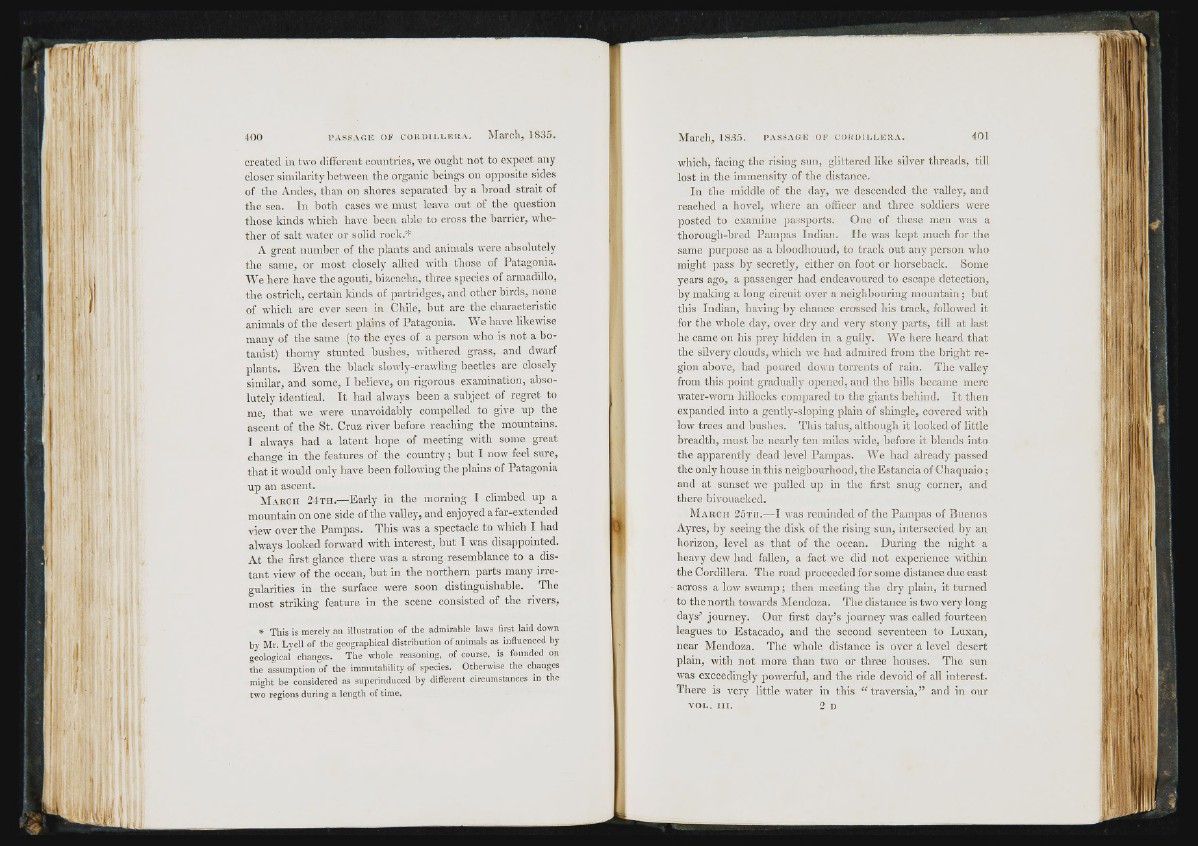
1: : -
I , . . ,
11 i
created in two (lifferent countries, we ought not to expect any
closer similarity between the organic beings on opposite sides
of the Andes, than on shores separated by a broad strait of
the sea. In both cases we must leave out of the question
those kinds which have been able to cross the harrier, whether
of salt water or solid rock.*
A great number of the plants and animals were absolutely
the same, or most closely allied with those of Patagonia.
We here have the agouti, bizcacha, three species of armadillo,
the ostrich, certain kinds of partridges, and other birds, none
of which are ever seen in Chile, but are the characteristic
animals of the desert plains of Patagonia. We have likewise
many of the same (to the eyes of a person who is not a botanist)
thorny stunted bushes, withered grass, and dwarf
plants. Even the black slowly-crawling beetles are closely
similar, and some, I believe, on rigorous examination, absolutely
identical. It had always been a subject of regret to
me, that we were unavoidably compelled to give up the
ascent of the St, Cruz river before reaching the mountains.
I always had a latent hope of meeting with some great
change in the features of the country; but I now feel sure,
that it would only have been following the plains of Patagonia
up an ascent.
M a r c h 2 4 t h .—Early in the inorning I climbed up a
mountain on one side of the valley, and enjoyed afar-extended
view over the Pampas. This was a spectacle to which I had
always looked forward with interest, but I was disappointed.
At the first glance there was a strong resemblance to a distant
view of the ocean, but in the northern parts many irregularities
in the surface were soon distinguishable. The
most striking feature in the scene consisted of the rivers,
• T h is is m e re iy a n iliu s tr a tio n o f th e a dm ira b ie laws first la id down
b y M r. L y e ll o f th e g eo g ra p h ic a l d is tr ib u tio n o f a n im a ls as in flu e n c e d by
g eo lo g ica l ch an g e s . T h e w h o le rea so n in g , o f co u rse , is fo u n d e d o n
th e a lu m p t i o n o f th e im m u ta b ility o f sp e cie s. O th e rw is e th e chan g es
m ig h t b e c o n s id e re d as s u p e r in d u c e d b y d iffe re n t c irc um s ta n c e s in th e
tw o reg io n s d u r in g a le n g th o f tim e .
which, facing the rising sun, glittered like silver threads, till
lost in the immensity of the distance.
In tlie middle of the day, we descended the valley, and
reached a hovel, where an officer and three soldiers were
posted to examine passports. One of these men was a
thorough-bred Pampas Indian. He was kept much for the
same purpose as a bloodhound, to track out any person who
might pass by secretly, either on foot or horseback. Some
years ago, a passenger had endeavoured to escape detection,
by making a long circuit over a neighbouring mountain; but
this Indian, having by chance crossed his track, followed it
for the whole day, over dry and very stony parts, till at last
he came on his prey hidden in a gully. We here heard that
the silvery clouds, which we had admired from the bright region
above, had poured down torrents of rain. The valley
from this point gradually opened, and the hills became mere
water-worn hillocks compared to the giants behind. It then
expanded into a gently-sloping plain of shingle, covered with
low trees and bushes. This talus, although it looked of little
breadth, must be nearly ten miles wide, before it blends into
the apparently dead level Pampas. We had already passed
the only house in this neigbourhood, the Estancia of Chaquaio;
and at sunset we pulled up in the first snug corner, and
there bivouacked.
M a r c h 2 5 t h .—I was reminded of the Pampas of Buenos
Ayres, by seeing the disk of the rising sun, intersected by an
horizon, level as that of the ocean. During the night a
heavy dew had fallen, a fact we did not experience within
the Cordillera. The road proceeded for some distance due east
across a low swamp; then meeting the dry plain, it turned
to the north towards Mendoza. The distance is two very long
days’ journey. Our first day’s journey was called fourteen
leagues to Estacado, and the second seventeen to Luxan,
near Mendoza. The whole distance is over a level desert
plain, with not more than two or three houses. The sun
was exceedingly powerful, and the ride devoid of all interest.
There is very little water in this “ traversia,” aud in our
V O L . I I I . 2 II
i
!ii
Jl
M1